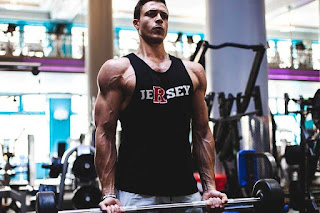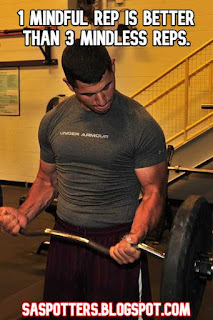If it's burning, it's working
If it’s burning its working is a phrase we often use at my gym. In fact, we even have it printed on the back of one of our shirts.
We want to teach our clients that it’s what we feel in the gym that is important. It’s easy for some people to get into a checklist mentality when they workout. They go to the gym with the exercise, sets, and reps that they are supposed to achieve written out or in their mind and they go through their list.
You can watch people going through the motions like this at the gym. In fact, we even see some of our clients getting into a mindset like this. They look at you for the next item on the list. We always remind our clients to not address their work out like a list but to be very mindful as they work out.
It’s especially important to be body aware. I try my best to put whatever I have on my mind on hold when I work out.
It’s not easy. Distractions like to come into the conscious mind. In fact, it’s very normal for the brain to try to anticipate what is next. It’s part of our biology. We need to counter that and really put our mind on our bodies as we work out to get the best results.
How present are you during your workouts?
It’s important to become body aware.
Very often we’ll ask a client where they feel a particular exercise. In some cases, the person does not really know for sure but just states that they feel an overall, general fatigue. What's the point of exercise if it isn't causing any changes in your body?
In some cases, there can simply be a form adjustment or form tweak to solve the issue. In other cases, the person is simply oblivious because they have not focused on the feeling of the set.
If that happens, it is our fault as trainers as well. Before we begin a set, one of the first things that I’ll do is remind a person where to put their focus. It really, really helps.
In my experience, there seems to be two types of people in the gym: those that are body aware and those that aren’t. I’m sure that there is probably a middle ground somewhere, but I haven’t seen it too often.
I’ve seen people that are totally body aware. They can tell you what they feel and where they feel it. There are others that seem like they don't have a clue.
I think that this is, in part, from early learning. Those that have had some yoga training appear to be far more body aware. Those that have had a coach or trainer that was all about getting the work in seem to have very little body awareness - and they are also the ones that are the most extrinsically motivated.
As trainers we want to teach all of our clients to be body aware and learn to become intrinsically motivated. It’s about the feel.
How to be body aware while strength training
The first thing we must do is know exactly where we are supposed to be feeling the exercise.
Body building should be about the feel. Don’t let the term body building throw you. If you are trying to get stronger and add muscle of any kind; you are building your body, hence, body building.
Many trainers teach the acute program variables. These variables for strength training are the exercises, sets, reps, load, rest, and tempo. They are all important.
Where we put our focus during a workout is equally important. For example, I personally believe that if you grabbed any light weight, did a particular exercise, and stayed laser focused the entire set and did it until you no longer could; you would get more out of that than a person that did 3 sets of 12 reps with the ideal weight but did it mindlessly. Fight me on that!
The best thing to do is get the acute program variables set up for your goal and do it with complete body awareness.
Determine which muscle is working during each exercise
The first thing to do when you want to be totally body aware during a set of exercise is know exactly what part of the muscle you are working.
For example, you may be working the deltoids - but where in the deltoids is the exercise targeting? Is it the anterior, medial, or posterior? Put your mind there. Touch it first. Put your finger on the part of the muscle that you plan on targeting and contract it.
Next, make sure that you know what the full range of motion is. Too many people end up doing partial ranges of motion because they have never been taught how to go through the full range of motion.
Make sure that you really know the proper form before starting. Make sure that every other muscle that is supporting you stays tight. If you are standing, for example, engage your core so that you are keeping your spine in the correct alignment.
A lot of times, people are completely unaware of their posture. Before you start, check your posture.
Use the right weight
Next, use a weight where you can really stay focused on the exercise. A lot of times, trainees use too heavy of a load and they can only focus on that. It's better to use a lighter load and do it right than it is to go heavy and not target the area you are trying to work.
Weight is subjective in many ways. What is heavy to you might be light for another and vice versa. Just use the right load for you so that you can zero in on the muscle.
Speed determines success
When you lift, make sure that you go at a tempo where you can stay focused on the movement. On the negative or lowering portion, go slower than on the lifting portion and really ensure that you are going to your full range of motion.
I say your full range of motion because it is slightly different for everyone. What do your joints allow? Fuller is better if you don't have pain in the joint.
Focus on squeezing the muscle
As you start the lifting portion of the lift, make sure that you squeeze the muscle that is being contracted all the way through. For example, make sure that you squeeze the biceps as hard as you can like a body builder doing a biceps pose as you curl the weight during bicep curls.
When you get to the top of the movement, squeeze before lowering. As you lower, feel the negative all the way down. Don’t just let the weight down. Make sure that you feel the load going down slow. Get the full range of motion at the bottom and do it all over again.
Focus on your breath
This focus is hard. We all get sidetracked and lose focus. The key, just like meditation, is to get the focus back.
Another way to become more body aware when lifting is to focus on your breath. Breathe in through the nose on the eccentric part of the lift which is the lowering portion. Blow the air out through the mouth on the concentric portion of the lift which is the lifting portion.
This also helps keep you in a nice rhythm.
If it’s burning, it is working. Body building is as much art as science. Yes, we know the ins and outs of the science well in 2021.
I’m an exercise physiologist and I’ve seen the science. We know what paper says are the best exercises, sets, reps, and loads for a particular goal, but we must stay focused if we want to get the most out of it.
The body really reacts to where we put our focus. I believe that 100%. I have a psychology degree as well and psychology is as important (or even more important) when it comes to exercise.
Can you focus on what you are trying to accomplish or are you daydreaming? Daydreaming while working out is still better than not working out, but my suggestion would be to really take advantage of your time in the gym. Get body aware.
Give yourself that nice break from your mind going off in different directions. Not only will you get more long-term benefits down the road from doing that, but you will also leave the gym in a better mood.
This article is written by Rob Maxwell (learn about his education), M.A. Exercise Physiology, CSCS and ACSM CPT from www.fittothemax.net. Follow him on Twitter.








No comments:
Post a Comment